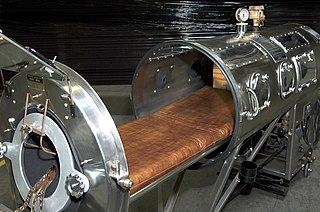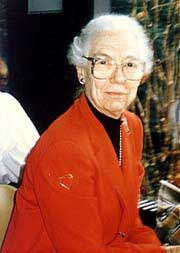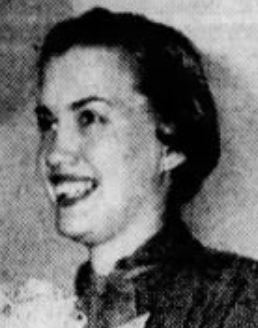
Ann Adams (1926-1992) was an American artist who, after becoming almost fully paralyzed due to poliomyelitis, re-learned to draw by using a pencil held in her mouth. [1] [2] [3]

Ann Adams (1926-1992) was an American artist who, after becoming almost fully paralyzed due to poliomyelitis, re-learned to draw by using a pencil held in her mouth. [1] [2] [3]
Adams was born in Jacksonville, Florida, and had a sister, Margaret. [4] At age 19, Adams married a Navy officer. [4] Their only child, a son named Kenneth, was born two years later. [4]
At age 24, in 1950, Adams contracted polio after the Georgia/Florida game where she caught a chill after crossing the river in a boat that night. The last time her sister saw her move was that night as she danced with her brother-in-law to Glenn Miller. She was an art major before getting married at Florida State University [5] and had started art school in Jacksonville in 1950. She was working at the shipyard in Jacksonville at the time when she became ill. The disease totally destroyed and paralyzed all but a few facial and neck muscles. [4] She spent a year and a half in a hospital in Jacksonville and another year and a half in a rehabilitation center in North Carolina. After this, Adams spent five years, spending up to 24 hours a day, inside an iron lung due to her inability to breathe on her own. [4] Polio does not destroy the nerves so she still had feeling through her body.
Her husband was unable to cope with Adams' disability, divorcing her three years after contracting the illness and he received primary custody of their son due to her hospitalization. Her parents cared for her during this time, and the March of Dimes (then the National Foundation for Infantile Paralysis) provided financial and medical assistance. [4] Under the care of the Central Carolina Convalescent Hospital, she lay in a rocking bed which helped her body, paralyzed from the neck down, breathe. Her mind was alert and she was given an adaptive device [6] invented by Frank Reck [7] and made by a dentist, Dr. Coble, that allowed her to type letters using her mouth. She was also fitted with an electric typewriter and given a page turner, made by Harry Doll of Western Electric Company, so that she could read a book by herself. [6] [7]
The Southeastern Respiration and Rehabilitation Center in Augusta, Georgia, provided Adams with a corset breathing device, where a rubber bag mimicked the negative pressure needed to breathe so that she could spend four hours a day where she was free of the iron lung; additionally, the center had a unique rocking bed and mouth hose device that allowed her to sleep normally, which meant that she could spend twelve hours a day outside the iron lung. [4] Despite this freedom, it was eight years before she was able to return to artistic pursuits. She told her sister Margaret that the "positive Pressure" machine allowed her to embrace her art again and allowed her to express herself. Margaret says Ann is the bravest person she has ever known.

After she was able to sit up in a wheelchair with a breathing device, [7] she trained herself to draw using a pencil held between her teeth [7] with a mouth grip. An adjustable easel was set up to hold her paper and a tray for paints. She finished her first drawing of a chapel in the woods ten years after getting polio. [5] Each of her works of art took about two months to complete. [7] [8] She made drawings and paintings that were used in Christmas cards, [9] [7] like Madonna and Child. [10] She also made drawings for other greeting cards and was nationally known for that work. Some of the drawings included landscapes, puppies, and kittens. [11] The drawings were printed and sold [5] through her mail-order business. [11]
By 1972, she supported herself with her artwork, living in her own home, and traveling with a portable iron lung. She required constant care and was still spending her nights in an iron lung. [5] She was still working in 1990. [12] She encouraged other people with disabilities and enjoyed reading, listening to music, and cooking. [11]
Adams was born in a Presbyterian family, but in 1956 converted and was baptized into the Roman Catholic Church. [13]

Poliomyelitis, commonly shortened to polio, is an infectious disease caused by the poliovirus. Approximately 75% of cases are asymptomatic; mild symptoms which can occur include sore throat and fever; in a proportion of cases more severe symptoms develop such as headache, neck stiffness, and paresthesia. These symptoms usually pass within one or two weeks. A less common symptom is permanent paralysis, and possible death in extreme cases. Years after recovery, post-polio syndrome may occur, with a slow development of muscle weakness similar to that which the person had during the initial infection.

An iron lung is a type of negative pressure ventilator (NPV), a mechanical respirator which encloses most of a person's body, and varies the air pressure in the enclosed space, to stimulate breathing. It assists breathing when muscle control is lost, or the work of breathing exceeds the person's ability. Need for this treatment may result from diseases including polio and botulism and certain poisons.

Ida Lupino was a British actress, director, writer, and producer. Throughout her 48-year career, she appeared in 59 films and directed eight, working primarily in the United States, where she became a citizen in 1948.

Margaret D. H. Keane was an American artist known for her paintings of subjects with big eyes. She mainly painted women, children, or animals in oil or mixed media. The work achieved commercial success through inexpensive reproductions on prints, plates, and cups. It has been critically acclaimed but also criticized as formulaic and cliché. The artwork was originally attributed to Keane's ex-husband, Walter Keane. After their divorce in the 1960s, Margaret soon claimed credit, which was established after a court "paint-off" in Hawaii.

The history of polio (poliomyelitis) infections began during prehistory. Although major polio epidemics were unknown before the 20th century, the disease has caused paralysis and death for much of human history. Over millennia, polio survived quietly as an endemic pathogen until the 1900s when major epidemics began to occur in Europe. Soon after, widespread epidemics appeared in the rest of the world. By 1910, frequent epidemics became regular events throughout the developed world primarily in cities during the summer months. At its peak in the 1940s and 1950s, polio would paralyze or kill over half a million people worldwide every year.

Virginia Grace Wilson "Gini" Laurie was a central figure in the 20th century development, in the United States, of the independent living movement for people with disabilities. It is sometimes said that she was one of its two "grandmothers"—the other one being Mary Switzer, who was in charge of vocational rehabilitation at the national level from 1950 to 1970.
Dianne Odell was a Tennessee woman who spent most of her life in an iron lung. She contracted "bulbo-spinal" polio at age 3 in 1950 and was confined to an iron lung for the rest of her life. Due to a spinal deformity caused by the polio, she was unable to change to a portable breathing device introduced in the late 1950s. Odell's condition was not as severe in youth and she could spend short periods outside the machine until her 20s, from then on she needed to be in it 24 hours a day. Caregivers could still slide Odell's bedding out of her iron lung for basic nursing care but only briefly.
Carol Brewster was an American actress and model.
June Margaret Middleton was an Australian polio survivor who spent more than 60 years living in an iron lung for treatment of the disease. In 2006, Guinness World Records recognised her as the person who had spent the longest amount of time living in an iron lung. This record has since been surpassed by American lawyer Paul Alexander.
A negative pressure ventilator (NPV) is a type of mechanical ventilator that stimulates an ill person's breathing by periodically applying negative air pressure to their body to expand and contract the chest cavity.

Leverett Saltonstall was an American political figure who served as Collector of Customs for the Port of Boston.

Joyce Holden was an American film and television actress.
Robin Francis Cavendish, MBE, was a British advocate for people with disability, medical aid developer, and one of the longest-lived responauts in Britain. Born in Middleton, Derbyshire, Cavendish was affected by polio at the age of 28. Despite being initially given only three months to live, Cavendish, paralyzed from the neck down and able to breathe only with the use of a mechanical ventilator, became a tireless advocate for disabled people, instrumental in organising the first records of the number of responauts in Britain and helping to develop numerous devices to provide independence to paralyzed people.

Harriet Bell was an American advocate for disability rights. She was a co-founder and director of the Polio Information Center and a member of the New York State Board for Nursing. Residing in the Goldwater Memorial Hospital after contracting polio, she was president of the hospital board for four terms, participating in drafting the Patients' Bill of Rights. In 1982, she was the recipient of the Wonder Woman Foundation Award of Warner Communications Inc. as an agent of change.

Elizabeth Twistington Higgins MBE was a British ballet dancer, and later a painter.

Rosemary Front was an American speech pathologist and disability rights advocate.
Paul Richard Alexander is an American lawyer and paralytic polio survivor. He is the last person living in an iron lung after he contracted polio in 1952 at the age of six.

Lorna VindenAnderson, born Lorna Margaret Skidmore, was a Canadian wheelchair athlete, competing in pentathlon, track and field, archery, and swimming events at the 1967 and 1969 Wheelchair Pan American Games, and the 1968 Paralympics in Tel Aviv.

Margaret Sigrid Rood was an American occupational and physical therapist. She developed techniques for treating central nervous system dysfunction, now known as Rood techniques or Rood's approach.

Floy LaVonne Currey Schoenfelder was an American disability rights advocate. She co-founded and directed the Polio Survivors Foundation, based in Reseda, California.
{{cite web}}: CS1 maint: bot: original URL status unknown (link)